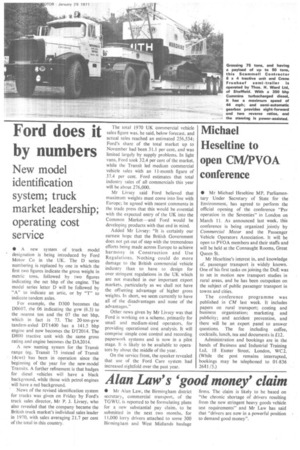Ford does it by numbers
Page 17

If you've noticed an error in this article please click here to report it so we can fix it.
New model identification system; truck market leadership; operating cost service
• A new system of truck model ' designation is being introduced by Ford Motor Co in the UK. The D series numbering is replaced by one in which the first two figures indicate the gross weight in metric tons, followed by two figures indicating the net bhp of the engine. The model series letter D will be followed by "A" to indicate an artic, or by "T" to indicate tandem axles.
For example, the D300 becomes the D0607, the 06 indicating the gvw (6.3) to the nearest ton and the 07 the net bhp, which in fact is 73. The 20-ton-gvw tandem-axled DT1400 has a 141.5 bhp engine and now becomes the DT2014. The D800 tractive unit with the same gross rating and engine becomes the DA2014.
A new naming system for the Transit range (eg, Transit 75 instead of Transit 14cwt) has been in operation since the beginning of the year for the new-model Transits. A further refinement is that badges for diesel vehicles will have a black background, while those with petrol engines will have a red background.
News of the revised identification system for trucks was given on Friday by Ford's truck sales director, Mr P. J. Livsey, who also revealed that the company became the British truck market's individual sales leader in 1970, with sales averaging 21.7 per cent of the total in this country. The total 1970 UK commercial vehicle sales figure was, he said, below forecast, and actual sales reached an estimated 256,534; Ford's share of the total market up to November had been 31.1 per cent, and was limited largely by supply problems. In light vans, Ford took 32.4 per cent of the market, while the Transit led medium commercial vehicle sales with an 11-month figure of 37.4 per cent. Ford estimates that total industry sales of all commercials this year will be about 276,000.
Mr Livsey said Ford believed that maximum weights must come into line with Europe; he agreed with recent comments in the trade press that this would be essential with the expected entry of the UK into the Common Market—and Ford would be developing products with that end in mind.
Added Mr Livsey: "It is certainly our earnest hope that the British Government does not get out of step with the tremendous efforts being made across Europe to achieve harmony in Construction and Use Regulations. Nothing could do more damage to the British commercial vehicle industry than to have to design for over-stringent regulations in the UK which are not matched in our important export markets, particularly as we shall not have the offsetting advantage of higher gross weights. In short, we seem currently to have all of the disadvantages and none of the advantages."
Other news given by Mr Livsey was that Ford is working on a scheme, primarily for small and medium-sized operators, for providing operational cost analysis. It will comprise simple cost control and recording paperwork systems and is now in a pilot stage. It is likely to be available to operators by about the middle of the year.
On the service front, the speaker revealed that use of the Ford Care system had increased eightfold over the past year.




























































































